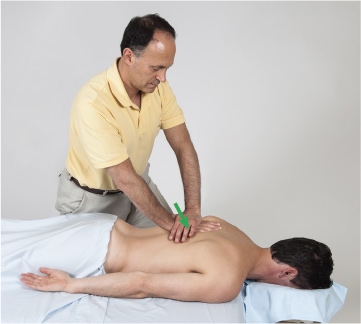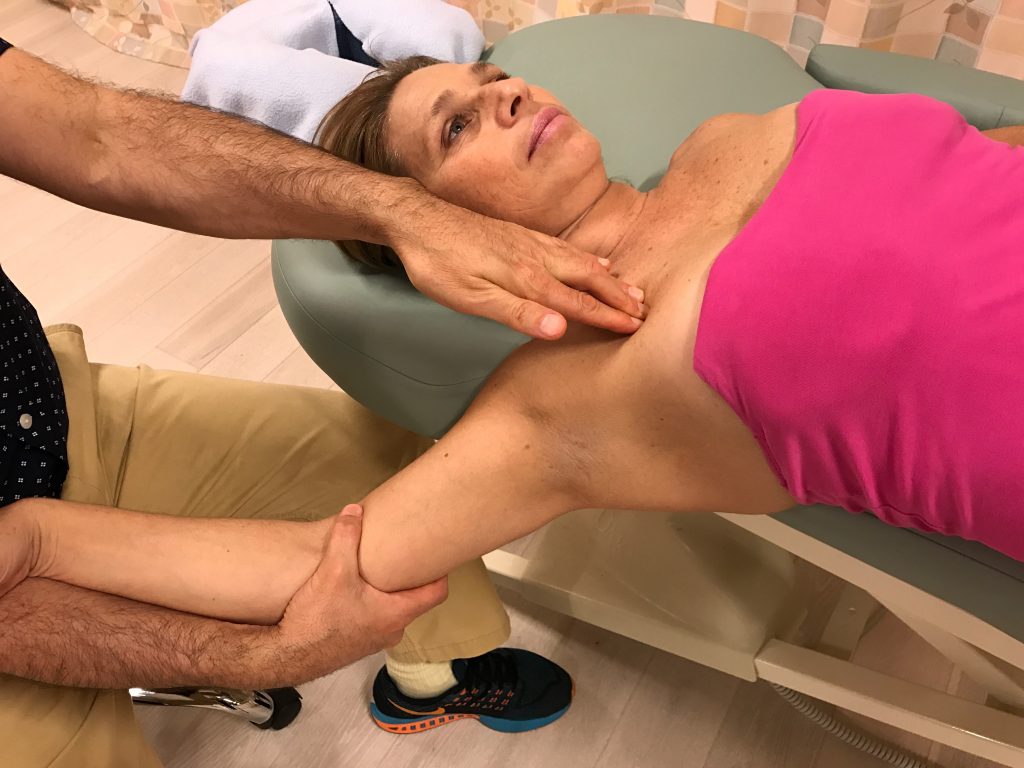Manual Therapy Treatment for Slumped Spinal Posture
Given that slumped spinal posture does not cause pain in the early stages, clients/patients often do not present for treatment until this condition is very chronic and progressed, and therefore stubborn and resistant to treatment. However, if consistent care is given, the pain and discomfort of slumped spinal posture can respond well to manual therapy. There are two aims of manual therapy for this condition. The first is to afford the client/patient relief from the pain and discomfort from the tight musculature. The second is to reduce the slumped spinal postural distortion pattern itself.
This tight musculature of this condition can range from the posterior thighs up the back to the head, and down to the shoulder girdles and arms posteriorly and anteriorly, and the anterior neck and pectoral region. But the main focus will usually be on the posterior paraspinal (erector spinae and transversospinalis) extensor musculature of the upper thoracic and cervical regions. Moist heat, massage, and stretching should all be performed to loosen the musculature of these regions. Joint mobilization (arthrofascial stretching) should then be performed to loosen the associated intrinsic fascial tissue of the joints. This aspect of treatment is extremely important. Without loosening the thoracic spinal joints, there is little chance of correcting this postural distortion pattern!

Joint mobilization (arthrofascial stretching) technique performed on the thoracic spine. Permission Joseph E. Muscolino.
When performing soft tissue massage, it is always wise to begin with light to medium pressure, and then transition to deeper pressure to break up long-standing fascial adhesions. At the tendons, cross fiber work should be performed. Once direct care to the cervicothoracic extensor muscles has been done, as time permits, it is wise to work all secondary areas affected by this condition (thighs, pelvis, low back, pectoral region, anterior neck, head, and arms). Stretching the trunk into extension is vitally important, as is joint mobilization (arthrofascial stretching) of the cervicothoracic spine and rib cage. For more stubborn cases, neural inhibition stretching techniques such as contract relax (CR) (also known as PIR or PNF) and agonist contract (AC) should be used.

Pin and stretch for the pectoralis minor. Permission Joseph E. Muscolino.
Reducing the slumped spinal postural distortion pattern is accomplished by working to loosen the hamstrings, anterior abdominal wall, and pectoralis musculature. In addition to soft tissue massage, stretching the hamstrings is very important. Because the lumbar spine has been stuck in excessive flexion for so long, stretching the lumbar spine (along with the thoracic spine) into extension is extremely important. Joint mobilization directed from posterior to anterior in direction to extend the lumbar spine (and thoracic spine) is also vitally important. Stretching and mobilization should be performed after moist heat and soft tissue manipulation have been performed for the lumbar region. Mobilization of the sacroiliac joints is also usually beneficial.
Ultimately, slumped posture will never be fully resolved unless the client/patient changes their habit of slumping into posterior pelvic tilt and spinal flexion when sitting. Given the likely weakness of the core musculature that is necessary to sit in a healthy posture, a strengthening program focused on extending and lengthening the spine may also be necessary for the client. Specific exercises for extension of the spine can be recommended (see the self-care for the client/patient section in a following blog article on this topic). However, recommending to the client/patient to begin Pilates, yoga, or fitness training is helpful.
Summary of Manual Treatment Protocol for Slumped Spinal Posture
| 1. Heat, soft tissue manipulation, stretching of the cervical and thoracic extensor muscles |
| 2. Joint mobilization (arthrofascial stretching) of the cervicothoracic spine and rib cage |
| 3. Neural inhibition stretching techniques can be used |
| 4. Heat, soft tissue manipulation, and stretching to the hamstrings, anterior abdominal wall, and pectoral regions |
| 5. Moist heat, soft tissue manipulation, stretching the lumbar region into extension |
| 6. Joint mobilization (arthrofascial stretching) of the lumbar spine into extension |
| 7. Joint mobilization (arthrofascial stretching) of the sacroiliac joints |
| 8. Work the pectoral region as well as the entire shoulder girdle and arm regions |
| 9. Counsel the client/patient regarding proper sitting posture |
| 10. Strengthen the extensor musculature of the spine |
Precautions/Contraindications for Slumped Spinal Posture
There are a number of precautions or contraindications that should be observed when working on a client/patient with slumped spinal posture. Stretching and joint mobilizing the lumbar spine into extension should be performed with extreme caution. All spinal joint mobilization is contraindicated if the client/patient has a pathologic disc in that region. Similarly, if abdominal wall stretching is done, exercise caution because stretching this region also requires bringing the lumbar spine into extension. If soft tissue manipulation is done to the anterior neck, be aware of the carotid artery and other sensitive structures. Before stretching the anterior neck into extension, first perform the vertebra artery competency test to see if it is safe. Stretching the anterior neck by bringing the cervical spine into extension can also be uncomfortable for many clients, especially elderly ones.


